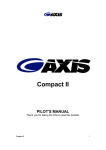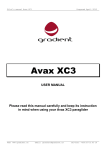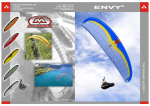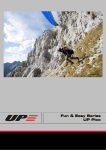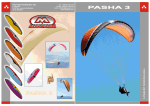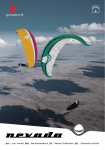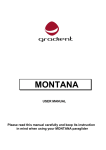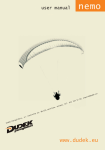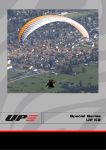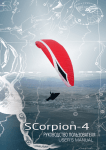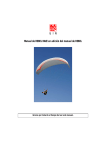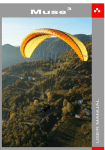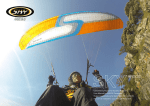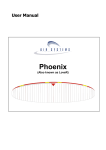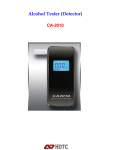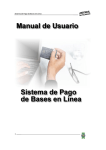Download Axis Vega IV User`s Manual
Transcript
VEGA IV PILOT'S MANUAL Thank you for taking the time to read this booklet. Vega 4 CONTENTS 1. Introduction 2. Pre flight • Pre-delivery inspection • Brake-line lengths • Weight range • Pre-flight safety 3. Flying the Vega 4 a. Normal flight • Pre-flight inspection • Launch • Flight • Landing b. Losing altitude • Big ears • B-line stall • Spiral dive c. Dealing with turbulence • Asymmetric collapse • Symmetric collapse • Deep stall • Full stall • Negative spin 4. Care, maintenance and repairs • Ground-handling • UV damage • Storage • Repairs 5. Technical details • Certification • Technical data • Line plan • Specification of materials 6. About Axis Vega 4 1. INTRODUCTION When setting out to design our next-generation cross-country glider we had a clear target: we wanted to create the best paraglider possible for discerning sports and recreational pilots. Pilots who want top performance and sensitive handling, but who rightly demand ever more security. The Vega 4 is that glider, keeping the comfortable but precise characteristics of the original Vega while improving on the glider’s already high performance and safety margins. With an internal structure based on the successful Mercury competition glider the Vega III includes our unique differential speed system. This means pilots can achieve a good sink-rate at half or one-third speed bar, and maintain good stability at maximum speed: in short, it gives the glider excellent usable speed. The Vega 4 is an intermediate-performance glider (EN-C, corresponding to old LTF -2 ) and is meant for qualified pilots who hold a full paragliding pilot licence. It is designed as an ideal cross-country glider, suitable for experienced pilots who fly regularly and who will enjoy a performance glider with good safety characteristics. This manual provides information about the glider, which will help you to fly safely and keep your wing in good condition. If after reading this manual you have any further questions, please don’t hesitate to contact us or any authorised Axis dealer. Thank you for choosing the new Vega 4 from Axis. www.axispara.cz SAFETY NOTICE By the purchase of this equipment, you are responsible for being a certified paraglider pilot and you accept all risks inherent with paragliding activities including injury and death. Improper use or misuse of paragliding equipment greatly increases these risks. Neither Axis nor the seller of Axis equipment shall be held liable for personal or third party injuries or damages under any circumstances. If any aspect of the use of our equipment remains unclear, please contact your local paragliding instructor, Axis dealer or the Axis importer in your country. 2. PRE FLIGHT Vega 4 Pre-delivery inspection The Vega 4 is delivered with a rucksack, inner bag, compression strap and this manual. The dealer or your instructor should have made a test inflation and test flight before delivery to you. Brake-line length When you receive your new Vega 4, the brake-line length is set the same as the Axis test glider. This length has been finely tuned by Axis test pilots and it should not be necessary to adjust it. If you feel it is necessary to adjust the brake-line length to suit physical build, height of harness hang points, or style of flying we recommend you test-fly the glider after every 20mm of adjustment. There should always be free brake travel when the glider is flown hands-up. This means when you look at your brake lines in flight with your hands up, there should be a slight bow, or arc, to the line – the brake lines should not be tight. This is to prevent the brakes being applied when the speed-system is used. Brake lines that are too short: • • • May lead to fatigue from flying with your hands in an unnatural position May impede recovery from certain manoeuvres Will certainly reduce your glider's speed range. Brake lines that are too long will: • • • Reduce pilot control during launch Reduce control in extreme flying situations Make it difficult to execute a good flare when landing. Each break line should be tied securely to its control handle with a suitable knot. Other adjustments or changes to your Vega 4 lead to a loss of guarantee, airworthiness and validity of EN certification and may endanger both yourself and others. If you have any suggestions on improvements let us know and our test pilots will try out your ideas in a controlled situation. Weight range Vega 4 The Vega 4 must only be flown within the certified weight range as shown in this manual. The weight range quoted is the total in-flight weight which includes pilot, glider, harness, clothing and accessories. Pre-flight safety Before flying this glider you should: • • • • • • Have the appropriate practical and theoretical training Have the required licence and insurance Be fit to fly and unaffected by stress or drugs Wear a suitable helmet Use a suitable harness and emergency parachute Make a thorough pre-flight check. 3. FLYING THE VEGA 4 Vega 4 We recommend you practice inflating your glider before flying it, and make your first flights in gentle conditions on a familiar flying site. A. Normal flight Pre-flight check A proper pre-flight check is essential for safe flying. Before launch lay the glider out into a slight arc and check that: • • • • • • • Cell openings are free of obstructions Lines are free of tangles or knots No twigs, grass or other objects are tangled in the lines Risers are correctly connected Brake lines run freely through the pulleys Knots on brake handles are secure Carabiners on risers are closed and/or tightened Launch The key to successful launching is to practice ground-handling on flat ground as often as possible. The Vega 4 inflates easily and steadily using forward or reverse launch techniques. There is no tendency to overshoot the pilot. To forward (alpine) launch in light or nil wind there is no need to pull the risers hard. Allow the glider to stabilise overhead and run positively forward checking the canopy is fully inflated and clear of any knots or tangles. Reverse launching is recommended in strong wind. Flight The best glide speed in calm air is achieved in the hands-up position. The best sink rate is produced with both brake lines drawn down equally to about 20% of their range. Turning The handling characteristics of the Vega 4 require no special or non-standard procedures. Brake pressure is progressive. This gives a responsive and sporty feel to the handling. In an emergency (e.g. a broken brake line) the Vega III can be manoeuvred by steering carefully with the rear risers or by weight shift. Using the speed system The speed system on the Vega 4 comes supplied with Brummel hooks ready to attach to your own speedbar of choice. When you have done this, check the speed system runs smoothly by hanging in your harness before flying. In particular check that the speed system won’t be engaged when in normal flight. Unnecessary knots and loops in a speed system are not recommended. Vega 4 Maximum useable speed is one of the strong points of Axis paragliders and the Vega 4 is no exception. However, in spite of this exceptional stability, any collapse at full speed will be more severe than the same event experienced at trim speed. Always keep both hands on the controls when flying fast and be ready to release the speed system immediately at the first sign of a collapse. Use the speed system carefully when flying close to the ground or the terrain. Landing On your first flights you may be surprised at how well the Vega 4 glides. Take account of this when making your landing approach and give yourself the opportunity for S-turns or a longer approach than you might be used to. For a normal, into-wind landing evenly pull the brakes all the way down when you are about one metre from the ground. Under nil-wind conditions, or if you are forced to make an emergency downwind landing, a wrap on each brake will allow you to make a stronger flare. B. Losing altitude Most pilots will, at some time, want to lose height. This may be because of a change in the weather, you are at cloudbase and don’t want to go any higher, or simply because you want to finish your flight quickly. Ideally, the best way to lose height is to find an area of sink and stay in it. This way you can fly normally to the ground. However, if there is no sink, or if you are in strong lift and want to go down, a rapid descent method may be needed. There are three main rapid descent methods: • • • Big ears B-line stall Spiral dive Each of these descent methods places extra, different stresses on gliders and should be avoided if you want to extend the life of the glider. It is important these manoeuvres are initially practiced under qualified supervision and preferably during a safety training course. Big ears Vega 4 This is the easiest and safest technique for descent while maintaining forward speed. Depending on how much of the wing-tip you deflate, 3m/s to 6m/s sink rate can be achieved. While in big ears your forward speed can be increased by using the speed system. The Vega 4 can be steered with big ears in by weight-shift alone. Initiation: Reach up as high as possible and take hold of the outer A-line on each side of the glider. Pull one in first, maintain direction, and then pull in the second. Hold them in firmly. Make sure the lines are pulled down equally on each side and your big ears are even. Recovery: Under normal circumstances the ears will come out on their own when the lines are released. Opening may be accelerated by slightly pumping the brakes. B-line stall This is an effective way of making a rapid descent but doesn’t allow any forward speed. Initiation: Take hold of the B-risers just below the maillons and smoothly pull them down, twisting your hands until the canopy shows a span-wise crease at the B-line attachment points. It is difficult to pull at first but becomes easier as the aerofoil creases. Your sink rate will increase while your forward speed will reduce to practically zero. Don’t release the lines immediately - the glider should be left to settle before releasing. Recovery: Let go of the risers smoothly but determinedly and symmetrically. The Vega III automatically returns to normal flight without any deep stall tendencies but may dive slightly forward. If the risers are released slowly and very unevenly the glider could start to spin. Spiral dive The spiral dive is the most effective way of making a fast descent. During the spiral dive the pilot and glider will experience strong centrifugal forces which strain the glider. As such it should be considered an extreme manoeuvre. Initiation: Weight shift and smoothly pull on one brake so the glider goes from a normal 360-degree turn into a steep turn and from there into a spiral dive. Once established in the spiral the descent rate and bank angle can be controlled with weight shift and the outer brake. Recovery: The Vega 4 recovers from a spiral spontaneously as soon as the brakes are released and weight shift returns to neutral. To exit allow the spiral to slow for a turn or two by applying outer brake and weight shift then release smoothly. Always finish a spiral dive at a safe altitude. Vega 4 C. Flying in turbulent conditions Deflations can occur when flying in turbulence but in most situations the Vega 4 will stabilise without pilot input. Flying with a little brake applied equally will help to prevent deflations and allow you to experience more direct feedback. Active flying will help avoid deflations. The aim is to keep the glider above your head in all situations by responding correctly to the glider's movements by using the brakes and weight shift. It is important these manoeuvres are initially practiced under qualified supervision and preferably during a safety training course. Asymmetric collapse The Vega 4 will normally re-inflate after an asymmetric collapse without input from the pilot, but the wing will turn towards the collapsed side. You should always maintain course and direction by weight-shifting away from the collapsed side. This can be reinforced by applying a small amount of brake on the opposite side to the deflation. If the collapse stays in, the collapsed side can be re-inflated by pumping the brake on the collapsed side in a firm and smooth manner. If you experience a big collapse while accelerated the canopy will fall behind you due to the difference in inertia between you and the canopy. You must wait until you pendulum back under the canopy before dealing with the deflation. Reacting too early can risk stalling the glider completely. Release the speed-bar immediately if you have a big collapse during accelerated flight and, while keeping weightshift neutral, apply slight brake to the open side. Let the glider enter a turn if space allows in order to avoid a spin or stall. Symmetric collapse A symmetric, or frontal, collapse will normally reopen without any pilot input. The Vega 4 will regain airspeed with a small surge. Be careful not to brake while the glider is behind you as this could induce a stall. Deep stall The Vega 4 has no tendency to either get into, or stay in, a deep stall. If the glider does enter a deep stall, accelerate the glider out of the deep stall by either pushing on the A-risers or by using the speed bar. Never try to steer out of a deep stall. A wet glider has a higher tendency to deep stall, so if you pass through rain accelerate a little and avoid using big-ears until the glider is dry. Vega 4 Full stall This is an extreme manoeuvre that should rarely, if ever, be required. To induce a full stall take one or two wraps of the brake lines and pull both of them down smoothly. Hold them down, locking your arms under your seat until the canopy falls behind you and deforms into a characteristic crescent shape. In a stable full stall the canopy will oscillate back and forth. Be careful not to release the brakes prematurely or asymmetrically. The Vega 4 recovers from a full stall automatically after the brakes are released. During correct recovery, where the brakes are let up a little to allow air to enter the glider prior to being released when the glider is in front of you,the Vega 4 shows no tendency to surge strongly in front of the pilot. If the brakes are released prematurely or too quickly there is a possible tendency for the glider to surge. This can be corrected by simultaneous equal braking on both sides. Be careful not to release the brakes asymmetrically as this can cause a large asymmetric collapse followed by a tendency to enter a spin. Negative spin Should a spin occur the Vega 4 is capable of recovering automatically when the brakes are released. As the glider surges forward slow it down with the brakes to avoid the possibility of a front collapse or an asymmetric collapse which could cause a cravat. Always wait for the glider to be in front of you or above you never brake while it is behind you as this can risk a stall. Safety notice: The Vega 4 has excellent passive safety as shown by the certification tests. However, be aware that the Vega 4 can surge forward when a negative spin is released too quickly. Avoid releasing from a spin too quickly or while the glider is behind the pilot. Remember: A wrong manoeuvre at the wrong time may change a straightforward situation into a dangerous problem. Extreme manoeuvres also expose your glider to forces which may damage it. Practice these techniques under adequate supervision preferably during a safety training course. Vega 4 4. CARE, MAINTENANCE AND REPAIRS The materials used to construct your Vega 4 have been carefully chosen for maximum durability. If you treat your glider carefully and follow these guidelines it will last you a long time. Excessive wear can occur by bad ground-handling, careless packing, unnecessary exposure to UV light, exposure to chemicals, heat and moisture. Ground-handling • Choose a suitable area to launch your glider. Lines caught on roots or rocks lead to unnecessary strain on the attachment tabs during inflation. Snagging lines may rip the canopy fabric or damage lines. • When landing, never let the canopy fall on its leading edge. The sudden pressure increase can severely damage the air-resistant coating of the canopy as well as weaken the ribs and seams. • Dragging the glider over grass, soil, sand or rocks, will significantly reduce its lifetime and increase its porosity. • When preparing for launch or when ground-handling, be sure not to step on any of the lines or the canopy fabric. • Don't tie any knots in the lines. UV damage Protect your canopy and lines from unnecessary exposure to sunlight. Storage • Avoid packing your glider when it is wet. If there's no other way, then dry it as soon as possible away from direct sunlight. Be careful to avoid storing your canopy when damp or wet: this is the most common reason for canopy degradation. • Don't let your glider come into contact with seawater. If it does, rinse the lines, canopy and risers with fresh water and dry it away from direct sunlight before storing. • After flight or when storing, always use the inner protection sack. • When storing or during transport make sure your glider isn't exposed to temperatures higher than 50°C. • Never let the glider come into contact with chemicals. Clean the glider with clean lukewarm water only. Never clean using abrasives. • For long-term storage don't pack the glider too tightly. Leave the rucksack zip open when possible to allow any moisture to evaporate. Vega 4 Repairs • Small holes in the canopy can be repaired using adhesive tape. • Larger repairs or cell replacement should only be carried out by the manufacturer’s authorised agent. • Damaged lines should be replaced by your Axis dealer. When a new line has been fitted always check its length against its counterpart on the opposite side of the wing. After replacing a line always inflate the glider on flat ground to check that everything is in order before flying. • After tree or water landings always examine the glider carefully. If you suspect the glider may be damaged in any way contact your nearest authorised Axis supplier. • After 100 hours of flying or two years, whichever is sooner, your Vega III must be checked and tested by the manufacturer’s authorised agent. Vega 4 5. TECHNICAL DETAILS Based on the highly successful Vega III, the Vega 4 has a slightly changed profile with improved shaping of the wingtips to reduce drag and give better performance. The aspect ratio of 5.90, the high number of cells (61), and the reduced total line length gives the Vega 4 its proven high performance. The inner structure is a direct development from Axis’s Mercury competition glider with every third rib reinforced. The changes in the internal structure mean higher passive safety. The canopy is reinforced by tapes which connect attachment points inside the cells – this prevents distortion and helps the canopy keep its form. A new line system helps to reduce the length of the main lines. The brake attachments have been moved to the trailing edge to create more precise handling and feedback. All the stitching is on the inside of the canopy for greater protection. Testing and certification The Vega III has passed certification EN-C . The certification of each canopy and its serial number is found on the wingtip label. Certification is valid for all harnesses of ABS type. This type of harness allows a certain degree of adjustment to be made to the length of the waist strap. The recommended distance between the carabiners is 42cm. In common with all other paragliders, when cross-bracing is looser than the recommended 42cm, weight-shift control increases and the glider feels more sensitive. However, automatic recovery from a collapse when using slack crossbracing can be slower and more unpredictable. When cross-bracing is tighter, the pilot feels more stable but the effectiveness of weight-shift is less effective. The Vega 4 has been designed for hill and/or tow launches. It is not a paramotor wing. The use of a power unit, paramotor or motor with the Vega 4 has not been tested by the manufacturer or by the testing authority. Vega 4 Technical specification Vega 4 Size XS S M ML XL Zoom Max Wing Chord Area Span Aspect Ratio Projected Area Projected Span Projected A/R Number of Cells 93 242,73 21,81 11,35 5,90 19,00 9,16 4,42 61 97 253,17 23,73 11,83 5,90 20,67 9,55 4,42 61 100 261,00 25,22 12,20 5,90 21,97 9,85 4,42 61 102,5 267,53 26,49 12,51 5,90 23,08 10,10 4,42 61 Take Off Weight Min. Speed Trimm Speed Acc. Speed Min. Sink Rate Gliding Ratio Homologation weight 60-80 23 39 57 1 10 EN-C 5,4 75-95 23 39 57 1 10 EN-C 5,7 85-105 23 39 57 1 10 EN-C 5,9 95-115 23 39 57 1 10 EN-C 6,1 105,5 275,36 28,07 12,87 5,90 24,45 10,39 4,42 61 105130 23 39 57 1 10 EN-C 6,4 203 212 219 224 231 lines lenght Vega 4 Vega 4 lines lenght : NAME QUANTITY MATERIAL A1 A2 A3 A4 A5 A6 A7 A8 2 2 2 2 2 2 2 2 DC120 DC120 DC120 DC120 Vectraline 12240 Vectraline 12240 Vectraline 12240 Vectraline 12240 M 100% 1315 1191 1153 1182 1035 930 839 848 M1 M2 8 8 DC200 Vectraline 16330 1781 1493 AA1 AA2 2 2 PPSL 275 PPSL 200 3699 4008 B1 B2 B3 B4 B5 B6 B7 B8 2 2 2 2 2 2 2 2 DC120 DC120 DC120 DC120 Vectraline 12240 Vectraline 12240 Vectraline 12240 Vectraline 12240 1251 1121 1086 1123 986 895 813 829 BB1 BB2 STAB. 2 2 2 PPSL 275 PPSL 200 PPSL 160 3705 3997 4702 C1 C2 C3 C4 C5 C6 C7 C8 2 2 2 2 2 2 2 2 Vectraline 12240 Vectraline 12240 Vectraline 12240 Vectraline 12240 Vectraline 16140 Vectraline 16140 Vectraline 16140 Vectraline 16140 1338 1211 1174 1208 1067 972 884 892 MC1 MC2 4 4 Vectraline 16330 Vectraline 12240 1794 1491 Vega 4 D1 D2 D3 D4 2 2 2 2 Vectraline 12100 Vectraline 12100 Vectraline 12100 Vectraline 12100 1431 1311 1261 1281 CC1 CC2 2 2 PPSL 200 PPSL 160 3703 3976 A9 A10 B9 B10 C9 SA SB SC MSA MSB 2 2 2 2 2 2 2 2 2 2 Vectraline 12100 Vectraline 12100 Vectraline 12100 Vectraline 12100 Vectraline 12100 Vectraline 12100 Vectraline 12100 Vectraline 12100 Vectraline 16140 Vectraline 16140 669 587 657 591 1341 1130 1120 1177 637 631 R1 R2 R3 R4 R5 R6 R7 R8 R9 R10 R11 2 2 2 2 2 2 2 2 2 2 2 Vectraline 12100 Vectraline 12100 Vectraline 12100 Vectraline 12100 Vectraline 12100 Vectraline 12100 Vectraline 12100 Vectraline 12100 Vectraline 12100 Vectraline 12100 Vectraline 12100 1480 1132 1113 1041 1086 917 904 992 807 746 771 RR1 RR2 RR3 RR4 2 2 2 2 Vectraline 16140 Vectraline 16140 Vectraline 16140 Vectraline 16140 1205 998 955 926 RRR1 RRR2 RRR3 2 2 2 Vectraline 12240 Vectraline 12240 Vectraline 12240 2509 2298 3200 R 2 DFSL 200 2643 Vega 4 Vega 4 Specification of materials Canopy Upper surface: Porcher Sport: Skytex 38 E 9017 E25A, universal, 38 g/m2 Upper surf. leading edge: Porcher Sport: Skytex 38 E 9017 E25A, universal, 38 g/m2 Lower surface: Porcher Sport: Skytex 38 E 9017 E25A, universal, 38 g/m2 Lower surf. leading edge: Porcher Sport: Skytex 38 E 9017 E25A, universal, 38 g/m2 Ribs: Porcher Sport: Skytex 9017 E29A, hard finish, 40 g/m2 Reinforcement: Porcher Sport: SR Scrim-2420 Thread: Bonded nylon D60, D40 Suspension system Lines LIROS: Dyneema DC 120/ comp line, 0.85mm, minimum strength 120 daN LIROS: Dyneema PPSL 120/ PES cover, 1.15mm, minimum strength 120 daN LIROS: Dyneema PPSL 160/ PES cover, 1.40mm, minimum strength 160 daN LIROS: Dyneema PPSL 200/ PES cover, 1.42mm, minimum strength 200 daN LIROS: Dyneema PPSL 275/ PES cover, 1.mm, minimum strength 275 daN LIROS: Dyneema DFLS 200/ PES cover, 1.42mm, minimum strength 200 daN Cousin Trestec: Vectraline 12100/ comp line, 0.6mm, minimum strenght 50 daN Cousin Trestec: Vectraline 12240/ comp line, 0.9mm, minimum strenght 115 daN Cousin Trestec: Vectraline 16330/ comp line, 1.0mm, minimum strenght 145 daN Cousin Trestec: Vectraline 16140/ comp line, 1.0mm, minimum strenght 145 daN Risers: Guth & Wolf: PES Pre-stretched polyester, minimum strength 2000 daN Maillons: Elair Servis: Niro triangle 4/200, minimum strength 200 daN Speedsystem pulleys: Riley Fittings Australia, RM 302 Harken USA, Ball Bearing Pulley 467 Vega 4 6. ABOUT AXIS Axis started to design and make paragliders in 2001. Success swiftly followed and now many of the world’s best competition pilots choose to fly Axis. They have won podium places at competitions around the world, including at recent World Cup events and the World Championships. The lessons learned from these thousands of hours of competition success have been used to develop the Vega 4, a new generation of glider. We welcome feedback from you about your new Vega 4. Send it to us at [email protected] Please note We have made every effort to ensure that the information in this manual is correct but please remember it is for guidance only. It is not a training manual. It must not be used as a substitute for proper training under the direction of an approved body. The manual is subject to change without prior notice. Check the websites for updates and the latest information regarding Axis products. Enjoy your Vega 4! www.axispara.cz Vega 4 Produced by axispara.cz 2013 Vega 4




















